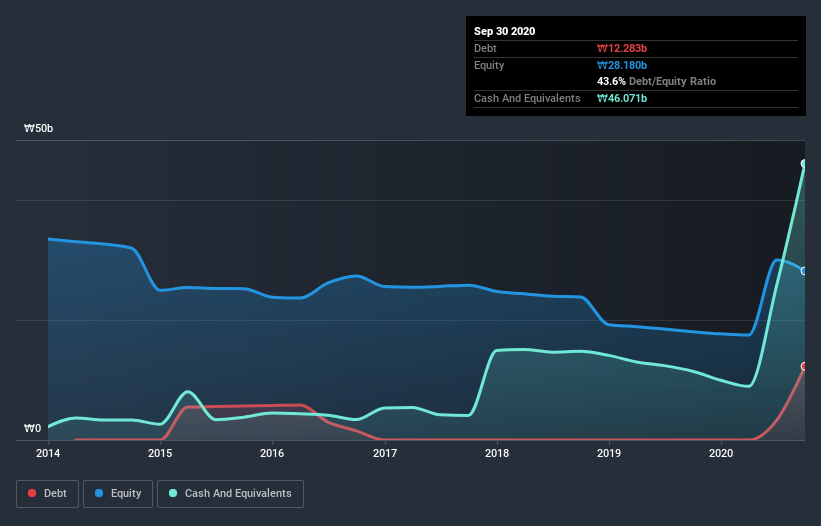- South Korea
- /
- Electronic Equipment and Components
- /
- KOSDAQ:A065650
Despite Lacking Profits Medifron DBT (KOSDAQ:065650) Seems To Be On Top Of Its Debt
Some say volatility, rather than debt, is the best way to think about risk as an investor, but Warren Buffett famously said that 'Volatility is far from synonymous with risk.' It's only natural to consider a company's balance sheet when you examine how risky it is, since debt is often involved when a business collapses. We can see that Medifron DBT Co., Ltd. (KOSDAQ:065650) does use debt in its business. But the real question is whether this debt is making the company risky.
When Is Debt Dangerous?
Debt and other liabilities become risky for a business when it cannot easily fulfill those obligations, either with free cash flow or by raising capital at an attractive price. In the worst case scenario, a company can go bankrupt if it cannot pay its creditors. However, a more usual (but still expensive) situation is where a company must dilute shareholders at a cheap share price simply to get debt under control. Of course, debt can be an important tool in businesses, particularly capital heavy businesses. The first thing to do when considering how much debt a business uses is to look at its cash and debt together.
See our latest analysis for Medifron DBT
How Much Debt Does Medifron DBT Carry?
You can click the graphic below for the historical numbers, but it shows that as of September 2020 Medifron DBT had ₩12.3b of debt, an increase on none, over one year. However, it does have ₩46.1b in cash offsetting this, leading to net cash of ₩33.8b.

A Look At Medifron DBT's Liabilities
We can see from the most recent balance sheet that Medifron DBT had liabilities of ₩29.2b falling due within a year, and liabilities of ₩1.21b due beyond that. Offsetting this, it had ₩46.1b in cash and ₩3.46b in receivables that were due within 12 months. So it can boast ₩19.1b more liquid assets than total liabilities.
This short term liquidity is a sign that Medifron DBT could probably pay off its debt with ease, as its balance sheet is far from stretched. Succinctly put, Medifron DBT boasts net cash, so it's fair to say it does not have a heavy debt load! When analysing debt levels, the balance sheet is the obvious place to start. But it is Medifron DBT's earnings that will influence how the balance sheet holds up in the future. So when considering debt, it's definitely worth looking at the earnings trend. Click here for an interactive snapshot.
In the last year Medifron DBT wasn't profitable at an EBIT level, but managed to grow its revenue by 70%, to ₩29b. With any luck the company will be able to grow its way to profitability.
So How Risky Is Medifron DBT?
Statistically speaking companies that lose money are riskier than those that make money. And in the last year Medifron DBT had an earnings before interest and tax (EBIT) loss, truth be told. Indeed, in that time it burnt through ₩2.8b of cash and made a loss of ₩3.5b. However, it has net cash of ₩33.8b, so it has a bit of time before it will need more capital. Medifron DBT's revenue growth shone bright over the last year, so it may well be in a position to turn a profit in due course. By investing before those profits, shareholders take on more risk in the hope of bigger rewards. There's no doubt that we learn most about debt from the balance sheet. However, not all investment risk resides within the balance sheet - far from it. Consider for instance, the ever-present spectre of investment risk. We've identified 2 warning signs with Medifron DBT (at least 1 which is potentially serious) , and understanding them should be part of your investment process.
When all is said and done, sometimes its easier to focus on companies that don't even need debt. Readers can access a list of growth stocks with zero net debt 100% free, right now.
If you decide to trade Medifron DBT, use the lowest-cost* platform that is rated #1 Overall by Barron’s, Interactive Brokers. Trade stocks, options, futures, forex, bonds and funds on 135 markets, all from a single integrated account. Promoted
Valuation is complex, but we're here to simplify it.
Discover if Hyper might be undervalued or overvalued with our detailed analysis, featuring fair value estimates, potential risks, dividends, insider trades, and its financial condition.
Access Free AnalysisThis article by Simply Wall St is general in nature. It does not constitute a recommendation to buy or sell any stock, and does not take account of your objectives, or your financial situation. We aim to bring you long-term focused analysis driven by fundamental data. Note that our analysis may not factor in the latest price-sensitive company announcements or qualitative material. Simply Wall St has no position in any stocks mentioned.
*Interactive Brokers Rated Lowest Cost Broker by StockBrokers.com Annual Online Review 2020
Have feedback on this article? Concerned about the content? Get in touch with us directly. Alternatively, email editorial-team@simplywallst.com.
About KOSDAQ:A065650
Hyper
A clinical stage biopharmaceutical company, focuses on the development of Alzheimer's disease (AD) and neuropathic pain treatments, and AD diagnostics.
Mediocre balance sheet with low risk.
Market Insights
Weekly Picks


Crazy Undervalued 42 Baggers Silver Play (Active & Running Mine)


Fiducian: Compliance Clouds or Value Opportunity?

Willamette Valley Vineyards (WVVI): Not-So-Great Value
Recently Updated Narratives

Watch Pulse Seismic Outperform with 13.6% Revenue Growth in the Coming Years

Significantly undervalued gold explorer in Timmins, finally getting traction

Moderation and Stabilisation: HOLD: Fair Price based on a 4-year Cycle is $12.08
Popular Narratives


MicroVision will explode future revenue by 380.37% with a vision towards success


NVDA: Expanding AI Demand Will Drive Major Data Center Investments Through 2026





